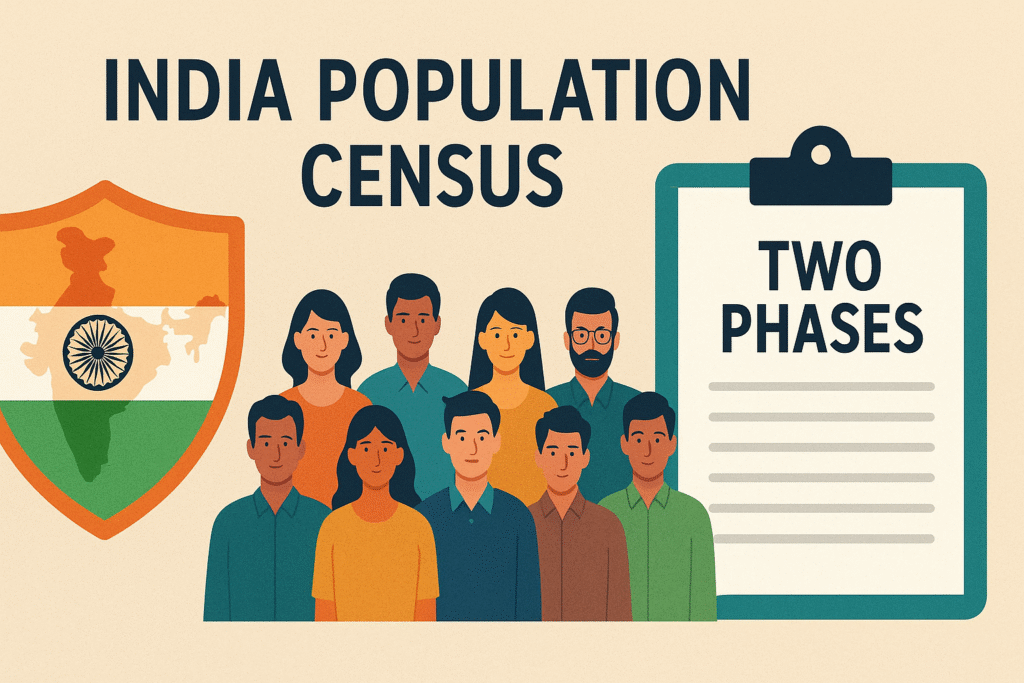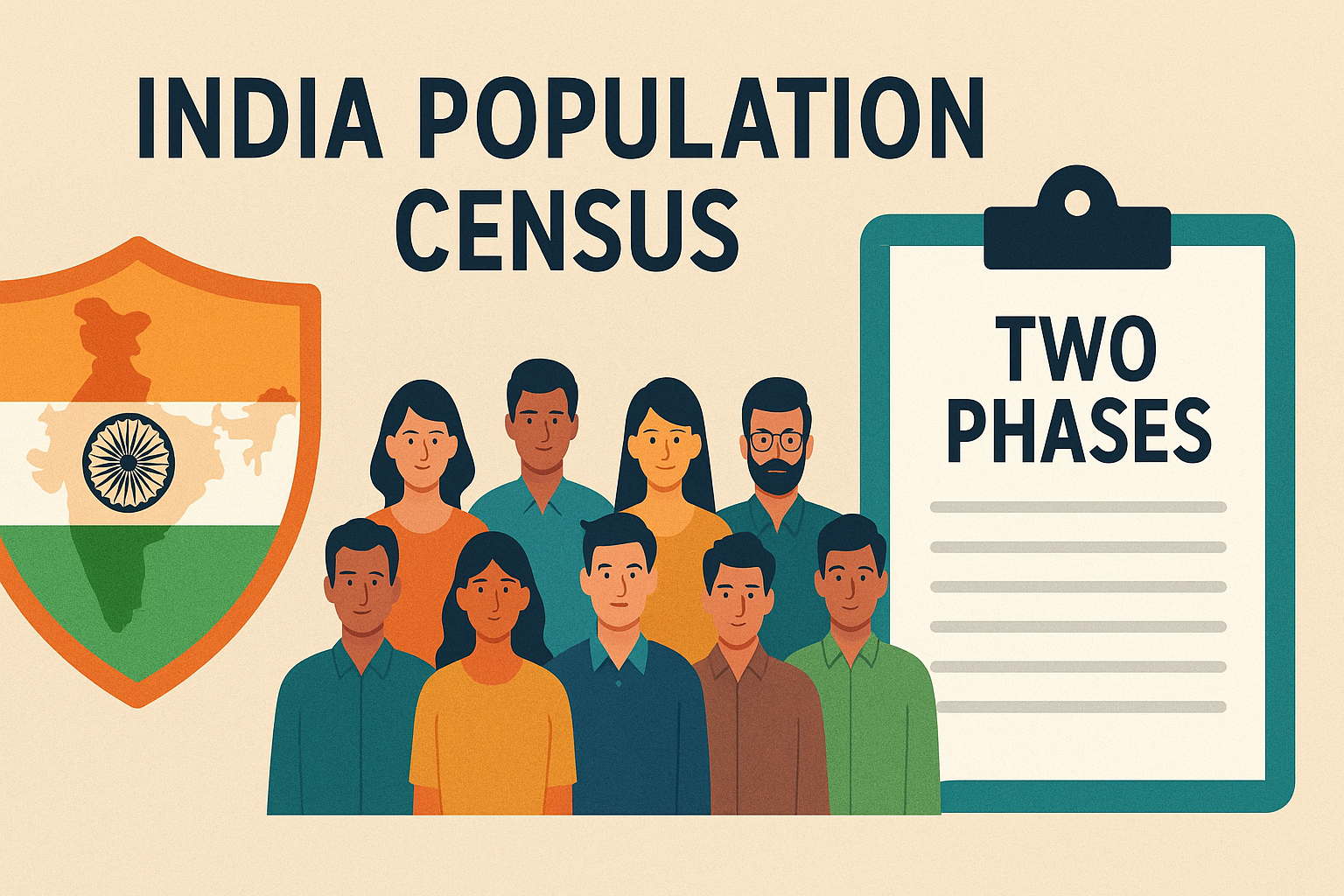Centre Reveals Two-Phase Plan for India’s First Census Since 2011

In a landmark announcement, the Union Home Ministry confirmed that India will undertake its long-overdue population census in two distinct phases, marking the first such national exercise since 2011. The news comes after over a decade of anticipation and amid significant policy shifts at the national level. The Centre reveals two-phase plan that is set to reshape India’s demographic and political future, with Phase 1 commencing on October 1, 2026, and Phase 2 beginning on March 1, 2027.
This extensive and detailed enumeration will not only include household assets and income but also dive deep into socio-economic, cultural, and even caste-based demographics—a first since India gained Independence. The Centre reveals two-phase plan in alignment with emerging national priorities and technological advancements, aiming to modernize the way census operations are carried out across the country.
First Phase: Houselisting Operation to Begin in October 2026
The first leg of the census exercise, termed as the Houselisting Operation (HLO), will kick off on October 1, 2026. This phase will gather comprehensive information on family income, ownership of assets, housing structures, and access to basic amenities such as electricity, water, and sanitation.
The most transformative aspect of this phase is its digital-first approach. Respondents will now have the convenience of filling out their information online, from the comfort of their homes. This marks India’s first digital census, a move aimed at enhancing accuracy, reducing costs, and ensuring wider participation.
As the Centre reveals two-phase plan, officials emphasize that the HLO is a critical component in understanding the economic structure of Indian households, which will in turn inform targeted policymaking.
Second Phase: Population Enumeration from March 2027
Following the Houselisting Operation, the second and more granular phase, called Population Enumeration (PE), is scheduled to start on March 1, 2027. This stage will delve into demographic data, socio-economic indicators, cultural affiliations, language preferences, and more.
For the first time since India’s Independence, caste will be officially recorded in the census. In April, Union Minister Ashwini Vaishnaw confirmed that caste enumeration will be a part of this upcoming exercise. This inclusion is expected to provide a deeper insight into the social composition of the population, potentially influencing future affirmative action policies.
The Centre reveals two-phase plan also includes detailed guidelines and training modules for census workers to ensure uniform data collection procedures across states and union territories.
Digital Revolution in Census Taking
A pivotal feature of this upcoming census is its digitization. Citizens can now self-enumerate via a secure government platform, increasing both transparency and user participation. Field staff will be equipped with tablets, enabling real-time data upload and reducing the likelihood of data manipulation or loss.
By leveraging technology, the Centre reveals two-phase plan aims to set a precedent for future data-driven governance models. This will also reduce the environmental impact of printing millions of census forms, marking a shift toward sustainable practices in public administration.
Policy Implications: Women’s Reservation and Delimitation
One of the most significant policy ramifications of this census is its role in activating the Women’s Reservation Bill. The bill, which proposes reserving one-third of seats in the Lok Sabha and State Legislative Assemblies for women, hinges on updated demographic data from a fresh census followed by a delimitation exercise.
Delimitation involves redrawing the boundaries of electoral constituencies based on population shifts and growth. Until now, this process had been frozen by constitutional amendments dating back to 1976 and extended by the 84th Amendment Act of 2001. However, the freeze is set to lift after the 2026 census, paving the way for much-needed electoral reforms.
By initiating the census, the Centre reveals two-phase plan that not only focuses on enumeration but also acts as a catalyst for legislative and electoral modernization.
Historical Context: A Long-Awaited Exercise
The last population census in India was conducted in 2011. The 2021 census was delayed indefinitely due to the COVID-19 pandemic and subsequent logistical challenges. This gap has left policymakers, researchers, and administrators operating with outdated data in a fast-evolving demographic landscape.
Now, as the Centre reveals two-phase plan, India prepares to bridge this data gap with a modern, inclusive, and technologically empowered approach. The success of this initiative is expected to significantly enhance planning across sectors such as health, education, infrastructure, and social welfare.
Stakeholder Responses and Public Reception
Initial reactions from policymakers, researchers, and civil society organizations have been largely positive. The inclusion of caste data is seen as a historic step that could reshape the socio-political narrative of the country. However, some critics have raised concerns about data privacy and the potential for misuse.
Government officials assure that robust safeguards will be in place to ensure the confidentiality of personal information. With digital literacy campaigns already underway, the Centre reveals two-phase plan also includes initiatives to educate citizens on how to safely participate in the digital census.
What Lies Ahead
With the official confirmation now public, the government is expected to roll out a detailed timeline for training, resource allocation, and technology deployment. The Centre reveals two-phase plan provides a clear roadmap, but its success will ultimately depend on efficient execution and public cooperation.
Over the next year, census officials will begin preparatory activities including pilot surveys, community engagement drives, and software testing. The government has also hinted at integrating Artificial Intelligence (AI) to streamline data analysis post enumeration.
Conclusion: A Defining Moment for India
As the Centre reveals two-phase plan, it sets into motion a series of initiatives that will impact not only how India counts its people but also how it shapes its governance, political representation, and resource distribution. This two-phase census is not just a data collection exercise—it’s a bold step into the future of India’s democratic and socio-economic architecture.
From ushering in the Women’s Reservation Bill to revamping electoral boundaries, the 2026–2027 census has the potential to redefine the country’s political and social landscape. With the nation’s attention fixed on this massive undertaking, the emphasis remains on transparency, inclusivity, and technological advancement.
In a rapidly changing world, accurate and current population data is the foundation of effective governance. Through its detailed strategy, the Centre reveals two-phase plan that aims to deliver just that—an informed and empowered India ready for the challenges and opportunities of the next decade.
